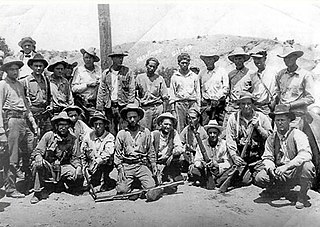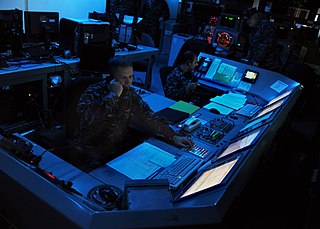Related Research Articles

The Posse Comitatus Act is a United States federal law signed on June 18, 1878, by President Rutherford B. Hayes which limits the powers of the federal government in the use of federal military personnel to enforce domestic policies within the United States. Congress passed the Act as an amendment to an army appropriation bill following the end of Reconstruction and updated it in 1956, 1981 and 2021.

Counterterrorism, also known as anti-terrorism, relates to the practices, military tactics, techniques, and strategies that governments, law enforcement, businesses, and intelligence agencies use to combat or eliminate terrorism.
A civilian is a person not a member of an armed force nor a person engaged in hostilities.
Aid to the Civil Power (ACP) or Military Aid to the Civil Power (MACP) is the use of the armed forces in support of the civil authorities of a state. Different countries have varying policies regarding the relationship between their military and civil authorities.
Rex 84B, short for Readiness Exercise 1984 Bravo, was a classified scenario and drill developed by the United States federal government to detain large numbers of United States residents deemed to be "national security threats" in the event that the president declared a National Emergency. The scenario envisioned state defense forces rounding up 500,000 undocumented Central American residents and 4,000 American citizens whom the US Attorney General had designated as "national security threats" as part of the secret Continuity of Government program. These people would be detained at 22 military bases in concentration camps run by the Federal Emergency Management Agency.

The Federal Protective Service (FPS) is a federal law enforcement agency of the United States Department of Homeland Security (DHS). It is also "the federal agency charged with protecting and delivering integrated law enforcement and security services to facilities owned or leased by the General Services Administration (GSA)"—over 9,000 buildings—and their occupants.
Militarization, or militarisation, is the process by which a society organizes itself for military conflict and violence. It is related to militarism, which is an ideology that reflects the level of militarization of a state. The process of militarization involves many interrelated aspects that encompass all levels of society.

Civil control of the military is a doctrine in military and political science that places ultimate responsibility for a country's strategic decision-making in the hands of the state's civil authority, rather than completely with professional military leadership itself. As such, a "fundamental requirement of any nation is to ensure that the activities of its armed forces are subordinated to the political purposes of constitutional government; hence, the armed forces must be under civil control". The concept of civil control falls within the overarching concept of civil-military relations representing the "societal imperative that the military remain subordinate to civil authority and that it reflect, to an appropriate degree, societal values and norms".

The Insurrection Act of 1807 is a United States federal law that empowers the president of the United States to deploy U.S. military and federalized National Guard troops within the United States in particular circumstances, such as to suppress civil disorder, insurrection, or rebellion.

The Military Cooperation with Civilian Law Enforcement Agencies Act is a United States federal law enacted in 1981 that allows the United States Armed Forces to cooperate with domestic and foreign law enforcement agencies. Operations in support of law enforcement include assistance in counterdrug operations, assistance for civil disturbances, special security operations, counter-terrorism, explosive ordnance disposal (EOD), and similar activities. Constitutional and statutory restrictions and corresponding directives and regulations limit the type of support provided in this area. The legislation allows the U.S. military to give law enforcement agencies access to its military bases and its military equipment. The legislation was promoted during the Presidency of Ronald Reagan in the context of the War on drugs, and is considered a part of a general trend towards the militarization of police.

As of 2020, more than 800,000 sworn law enforcement officers have been serving in the United States. About 137,000 of those officers work for federal law enforcement agencies.

The Adjutant General of Oklahoma is the highest-ranking military official in the state of Oklahoma, subordinate only to the Governor of Oklahoma. The highest officer of the Oklahoma National Guard, the Adjutant General is the principal advisor to the Governor on military affairs and the head of the Oklahoma Military Department as the Secretary of the Military.

Provosts are military police (MP) whose duties are policing solely within the armed forces of a country, as opposed to gendarmerie duties in the civilian population. However, many countries use their gendarmerie for provost duties.

The posse comitatus, frequently shortened to posse, is in common law a group of people mobilized by the conservator of peace – typically a reeve, sheriff, chief, or another special/regional designee like an officer of the peace potentially accompanied by or with the direction of a justice or ajudged parajudicial process given the imminence of actual damage – to suppress lawlessness, defend the people, or otherwise protect the place, property, and public welfare. The posse comitatus as an English jurisprudentially defined doctrine dates back to ninth-century England and the campaigns of Alfred the Great simultaneous thereafter with the officiation of sheriff nomination to keep the regnant peace. There must be a lawful reason for a posse, which can never be used for lawlessness.

United States Department of Defense Police are the uniformed civilian security police officers of the United States Department of Defense (DoD), various branches of the United States Armed Forces, or DoD agencies.
Defense Support of Civil Authorities (DSCA) is the process by which United States military assets and personnel can be used to assist in missions normally carried out by civil authorities. These missions have included: responses to natural and man-made disasters, law enforcement support, special events, and other domestic activities. A recent example of the use of DSCA is the military response to Hurricane Katrina. DSCA is the overarching guidance of how the United States military can be requested by a federal agency and the procedures that govern the actions of the military during employment.

American military operations other than war (MOOTW) focus on deterring war, resolving conflict, promoting peace, and supporting civil authorities in response to domestic crises.

The Department of the Army Civilian Police (DACP), also known as the Department of the Army Police, is the uniformed, civilian-staffed security police program of the United States Army. It provides professional, civilian, federal police officers to serve and protect U.S. Army personnel, properties, and installations. DACP personnel represent the Department of the Army's contribution to the Department of Defense Police program. DACP law enforcement officers primarily work alongside the U.S. Army Military Police Corps, the Army service members who hold law enforcement military occupational specialities. DACP officers are supplemented by Department of the Army Security Guards, who are uniformed and armed federal security officers, primarily responsible for entry control and basic security tasks. Although the Army Criminal Investigation Division employs civilian special agents, it does not fall-under the DACP or DoD Police umbrella.
The reserve components of the United States Armed Forces are military organizations whose members generally perform a minimum of 39 days of military duty per year and who augment the active duty military when necessary. The reserve components are also referred to collectively as the National Guard and Reserve.

The militarization of police is the use of military equipment and tactics by law enforcement officers. This includes the use of armored personnel carriers (APCs), assault rifles, submachine guns, flashbang grenades, sniper rifles, and SWAT teams. The militarization of law enforcement is also associated with intelligence agency–style information gathering aimed at the public and political activists and with a more aggressive style of law enforcement. Criminal justice professor Peter Kraska has defined militarization of police as "the process whereby civilian police increasingly draw from, and pattern themselves around, the tenets of militarism and the military model".
References
- 1 2 3 4 5 6 7 George Withers, Lucila Santos and Adam Isacson. Preach What You Practice:The Separation of Military and Police Roles in the Americas at the Wayback Machine (archived 26 September 2019) Washington Office on Latin America, November 2010. ISBN 978-0-9844873-4-9.
- ↑ PhD, Charlotte Lawrence, Cyrus J. O’Brien (2021-05-12). "Federal Militarization of Law Enforcement Must End | ACLU". American Civil Liberties Union. Retrieved 2024-05-21.
{{cite web}}: CS1 maint: multiple names: authors list (link)